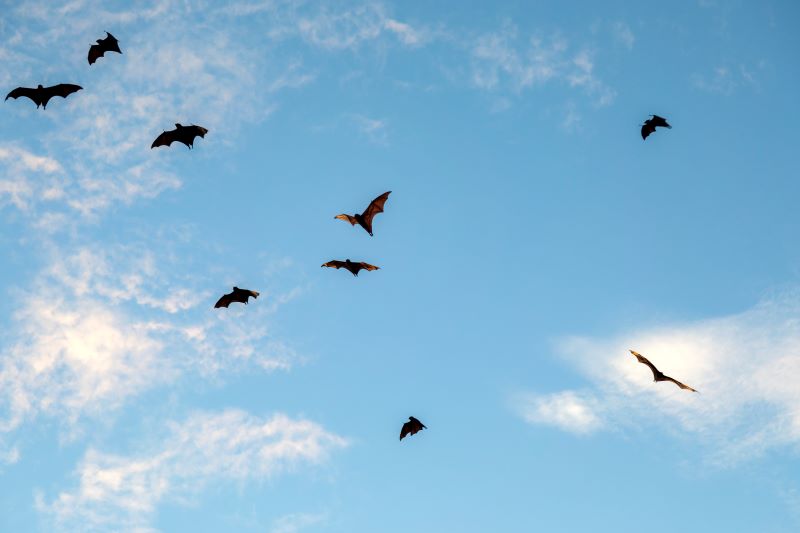Your spooky decorations just aren’t complete until you’ve hung up those rubbery black bats. And like them or not, nature wouldn’t be complete without the real bats.
This tiny-but-mighty mammal has been dubbed “an unlikely hero with global impact” by bat conservationists. So put those brooms and traps away and prepare to be amazed at everything bats do for us (aside from making the hair on our necks stand up).
Surprising Facts About Bats
We can’t make you love them, but we can help you see why we need them around.

Did someone say chocolate?!
Bees and butterflies aren’t the only pollinators in town. Bats also do their part, and not just in haunted houses. Many species of bats actually live in tropical locations and pollinate plants that produce tequila, chocolate, bananas, avocados and mangoes.
Bigger than the Texas oil industry
Bat droppings (guano) are an unpleasant discovery when found in our homes. But at one point in time, guano was Texas’s largest mineral export—even before oil!—thanks to its rich fertilization properties.
And did you know that roughly 1.5 million Mexican free-tailed bats reside in Austin, Texas? That’s right: These urban dwellers call the underside of the Congress Avenue Bridge home.
It might not make your bucket list, but Bracken Cave in San Antonio, Texas, has the world’s largest bat colony: population, anywhere from 15-20 million.
Making the blind see
For the record, bats aren’t blind. They just have a different way of seeing through sensing their surroundings. It’s called echolocation. While you won’t find seeing eye bats supporting the visually-impaired anytime soon, scientists have developed navigational aids for the blind through their study of echolocation.
Research on bats has also contributed to the development of vital vaccines, and nearly 80 medications come from plants that rely on bats for their survival.
Batting a thousand
Let’s look at the numbers, via the experts at Bat Conservation International:
- The oldest known bat lived at least 41 years.
- The world’s largest bat—called the giant golden-crowned flying fox—boasts a wingspan of up to 6 feet.
- Aptly called the bumblebee bat, the world’s smallest bat measures 1 to 3 inches in length and 2 grams (0.071 oz.) in weight.
- The Mexican free-tailed bat (the aforementioned bats that live under the bridge in Austin, Texas) are the world’s fastest. They fly in short bursts that clock around 100 mph.
- There are over 1,400 species of bats in the world. Don’t worry—only three of those are the kind that drink blood!
- Want to live in a world without bats? You’ll have to move to the desert or Antarctica, because bats can be found in every other habitat on the planet. Spanning six continents, bats dwell in rainforests, wetlands, woodlands and grasslands.
- Some studies suggest bats are worth upwards of $53 billion in pest control savings to the U.S. agriculture system. There are other ecosystems—such as forests which provide lumber—to which bats’ industrious nature also lends extraordinary value.
- Bonus fact: Whether this makes them more endearing or more frightening, it’s the strange truth — bats have belly buttons!

Protecting Your Home from Bats
Now that you know more about the value of bats, how do you keep them safe to do their important work without incurring damage to your property?
For all their good qualities, these small creatures can make a big mess if they get into your house. Here are a few pointers to protect your property.
1
Keep an eye on tight spaces.
To prevent bats from getting in where they don’t belong, you should regularly check areas where they tend to squeeze in: roof eaves, fascia, cornices, anywhere the pitch of your roof changes, or other roof venting and chimney areas. Seal any small or open cracks or slits with caulk, and cover eaves, vents and chimney tops with permanent screening or metal mesh installed by a professional.
2
Check your homeowners insurance policy.
Not all policies cover all types of animal damage. When it comes to bats, your policy might cover the damage they cause (i.e., shredded insulation), but not the cost of cleaning up their droppings. Learn more about potential scenarios and possible coverage issues.
3
Help bats get back outdoors.
How do you get bats back outside to catch bugs and pollinate plants instead of roosting in your rafters? Sticky traps and other inhumane means of evacuation are not recommended. The U.S. Fish & Wildlife Service does suggests these safe methods. Or contact a professional exterminator who employs humane methods of evicting the tiny tenants.

Attracting Bats to Your Property
Don’t have bats but wish you did? Have bats but want to keep them outside where they belong? Here are some ways to attract and provide shelter for these industrious night shift workers.
1
Make a bat box.
The installation should be 1o to 20 feet high in an area that receives at least six to eight hours of direct sunlight, but not situated near artificial lights. Here’s a helpful video and guide complete with supply lists and floor plans.
2
Leave the lights off.
Light pollution can disrupt or deter bats, so if you want to see them at work, you’ll need to keep it dark.
3
Create a bat-friendly garden or yard.
Minimize the use of pesticides and choose plants that attract pollinators from bugs to bats. If you have dead or dying trees on your property that are safely located away from your home, leave them for the bats as a roosting option.

The Bottom Line on Bats
Bats can be our friends if we keep a healthy distance and provide what they need to thrive. That said, experts don’t recommend handling them. While less than 1% of the bat population gets rabies, any bites should be washed immediately with soap and water and you should contact your doctor.
Learn anything new, or have fun facts or tips we didn’t share? Let us know in the comments!







Very interesting and insightful read! Loved it
This was fascinating and I understand the need to keep them protected. They are a very important part of our eco system. We would lose very much if we ever lose the bats. I don’t see them as “spooky”, but rather graceful workers who get a lost of bad press.
Interesting & helpful
I love bats! They help to keep the awful mosquito population under control on the property. We have bat houses and friendly surroundings, and don’t believe in using those awful chemicals. Thanks for making others aware of their benefits.
One night I witnessed two bats appearing to be mating and one of the bats glowed red! I’ve been told to see this is very, very rare. Wonder if that’s true or not?
I always knew bats were good but didn’t know that many bats were around. Especially in San Antonio. I think I’m going to put me a couple of bat boxes up at my property. I hate mosquitoes so I will endear the bats that can help me.
Very helpful!
Great to see good info on these useful and strangely adorable animals
Excellent article and info on bats. I thought that I knew a good amount them but this article clearly enlightened me
Great info. First time my husband and I met bats was in a sacred cave where worshippers were praying in BALI.
Some people are really aware of the value of bats. The famous store known as Hammacher Schlemmer actually sells ready-made bat houses for you to install on or near your home. They are online, I believe. Bats don’t eat bees – bees sleep at night and work during the day. Bats sleep days and feed at night. You can buy a bat house stand that stands in the middle of the yard.
loved this. I didn’t expect my insurance company to provide good information about bats, those amazing creatures. thanks. dm
Thank you for this wildlife-friendly post. I already knew about their beneficial qualities but nice to remind others.
Hey great article. NOW how about putting the instructions on how to build a bat box???
We must protect and conserve bats.
It was amazing and enlightening.